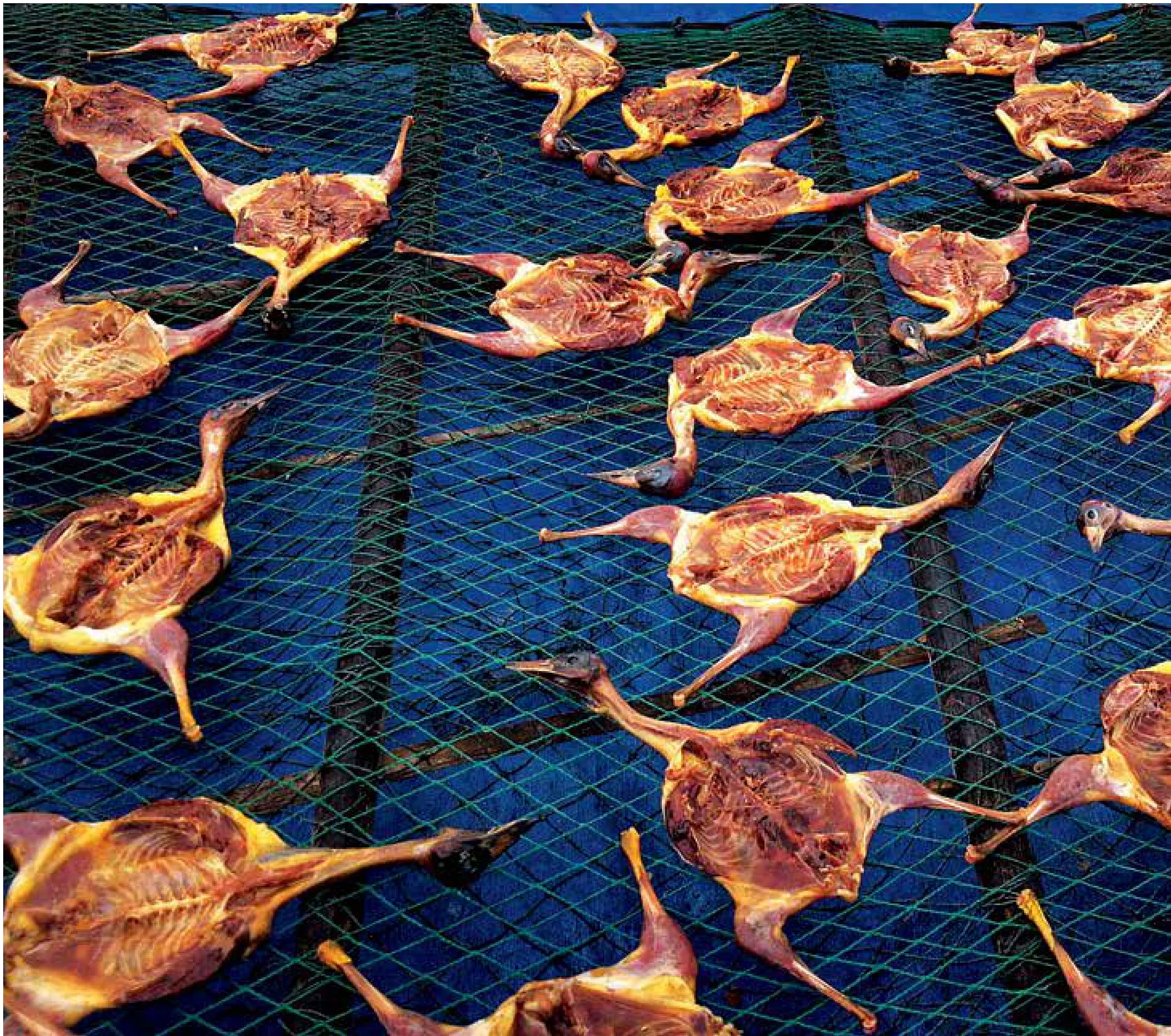NO FLY ZONE
2013-08-07BYGINGERHUANG黄原竟
BY GINGER HUANG (黄原竟)
NO FLY ZONE
BY GINGER HUANG (黄原竟)
China’s campaign against hunting migratory birds
候鸟属于天空,而不是餐桌
Wang Jianmin is a photographer in his fifties. At his age, wading in cold water in the already chilling October weather may not be such a good idea, but that is what he regularly does at the Beidagang Natural Reserve, Tianjin. Wang is one of the core members of a loosely-knit volunteer group of around 300 people who undertake the task of patrolling the 44,240-square kilometer wetland, keeping records of the numbers and conditions of migratory birds and guarding them against all forms of hunting.

On January 13, 2013, a volunteer, obviously grieved, rescues a poisoned swan in Dongting Lake, Hunan Province. It was the second and last swan he rescued that day; 20 other swans died.
Beidagang Natural Reserve is a vital stop for the birds migrating along China’s eastern coast. For some of them, this is only part of an epic journey starting from Russia and ending in Australia. There are eight major migration routes worldwide, and three of them run through China. When those beautiful long distance travelers fly over this vast country, the threats confronting them include shrinking wetlands, pollution, bewildering cities with glass facades, airports, and, worst of all, poachers.
A series of events in the past year have shown the shocking scale of bird killings all over China. At the Luoxiao Mountain in Guidong County, Hunan Province, millions of birds go through a series of narrow valleys every October. It is the second largest migration corridor in China, but today it is more often called the “corridor of death”. In October 2012, a documentary calledThe Atrocity of Birds(《鸟之殇》Niǎo Zhī Shāng) by journalist Li Feng showed that each hilltop held hundreds of hunters armed with recordings playing bird sounds, LED lights—and guns, lots of guns. The whole mountain lights up like a stadium and gunshots echo through the valleys all night long. In just one village, the yearly hunt amounted to 150 tons.
In November 2012, volunteers’ in the Beidagang Natural Reserve found dozens of rare species under first-grade state protection, poisoned by bait mixed with pesticides. Thirteen storks were saved as a result of the volunteers and NGOs’ immediate rescue actions, but over 60 dead birds were found in the wetlands in the following days. Besides poisoning, the most regular method for catching birds is via net. The nets are made of wires so thin that the birds cannot see them and end up getting tangled in them, not unlike a spider web. Before the migratory season ended, Beidagang’s volunteers had cleaned up over 20 kilometers worth of bird nets.
In October 2013, the Qingdao Wildlife Rescue Association, a wildlife NGO in Qingdao, discovered that the city’s mountains were densely packed with bird nets. The association quickly rallied a force of volunteers to chop down the nets, but much to their frustration the nets were immediately set up again just one day after their removal.
Dongting Lake is one of the biggest winter locations for Asian migratory birds; there are 262 kinds of aquatic birds in China, and 158 types are seen wintering in Dongting Lake. In 2012 however, the number of birds wintering there fell from over 20,000 to less than 10,000.While there used to be tens of thousands of birds flocking to the lake, last year the birds only came by the hundreds.

Slaughtered birds being processed in a shop in Leizhou Peninsula, Guangdong Province. Leizhou Peninsula is notorious for its bird hunting tradition, resulting in a drastic decrease in the bird population in recent years.
Often, the birds are used for food. A bird’s price varies from 5 RMB in a local rural market to thousands in wildlife restaurants. A swan, for example, could be sold for 3,000 RMB.
As a result, bird hunting has become common inChina’s rural areas. For a lot of Chinese rural residents, it is simply a means of extra income, nothing to do with morality or law. Wang Ligang is a farmer living at the bend of Yongding River in Tianjin, where egrets, ducks, swans, and hawks are seen stopping on their epic journey. He is known in his village for his bird trapping skills, and he doesn’t consider catching wild birds any different from fishing. Li Feng observed that, in Luoxiao Mountain, bird hunting is a tradition, and some hunters even bring their families and children to help when they hunt. Most of the bird hunters are rural residents with very low incomes; they can earn the equivalent of a year’s wages in just one afternoon’s hard work.
Theoretically, the understaffed Bureau of Forestry should be responsible for wildlife protection; however the power to stop the wildlife trade belongs to the Bureau of Industry and Commerce. In the small town of Guidong, Hunan Province, where everyone knows everyone, word spreads quickly when the inspectors come to call.
Deng Xuejian is a biology professor studying migratory birds in Hunan Normal University. He has been trying to find a new way to stop the hunting—not through law-enforcement but by using the economy. He drafted a proposal for the Bureau of Tourism, applying for funding to build a tourist site for visitors to watch the migrating birds:“Right now a dried bird only sells between three and 20 RMB. If villagers find out that birds bring in business and tourists and that they can earn much more money, then why would they bother hunting at all?”
Zhao Liang, the director of the NGO project Let the Birds Fly, in Tianjin, is also contemplating how to build a mutually beneficial relationship between the locals and the birds. If the birds cannot get sufficient food in the wetlands, they will not be able to proceed with their journey. The Beidagang wetland is surrounded by fish ponds, and naturally, the birds hunt the fish. “It is very important that the protection of the birds doesn’t harm the interests of the locals, because the locals know more about the wetland than any of us—making them indispensable in the protection of birds. The issue now is how to compensate them for the loss caused by the birds. We are trying to get subsidies for them from foundations, the government, and enterprise sponsorships,” says Zhao.
These long term plans, however, are still in the growing phase. Currently, volunteers are playing a major role in protection by doing what they can: destroying bird hunting devices, providing food for birds, and saving the sick ones. Most of the volunteers are university students, photographers, and even members of biking clubs.
According to Wang Jianmin, volunteering for migratory birds means devotion in every way; it puts the volunteers’ physical resilience to the test—trekking through the muddy, cold wetlands and giving up free time during migration season.
For Wang, the passion that drives him is his love for the creatures. “Once you start to watch birds you’ll fall in love with them because they are so intelligent, and their bonds are so affectionate.”
One story in particular drives Wang’s passion:“Once, we saved a poisoned white crane. It was very rare, with only around 1,000 left. I noticed that, while it was recovering under our care, four other white cranes were waiting in the wetlands and refused to take off. I realized that they were the same family and they didn’t want to lose their missing member. For days they stayed there. However, the recovery took too long, and the weather was growing colder. By the time the sick crane finally recovered, the other cranes already gave up waiting and took off. This made us very anxious because a bird can’t take on such an enormous task alone. It needs a large group where each member takes turns to lead the flock. Fortunately, another volunteer group observed that there was a flock of the same species resting in a wetland in the south. We drove 1,000 kilometers and took the crane back to its family, a happy ending.”
